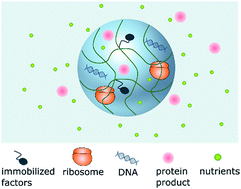Long-lived protein expression in hydrogel particles: towards artificial cells†
Abstract
Herein we report a new type of cell-mimic particle capable of long-lived protein expression. We constructed the cell-mimic particles by immobilizing the proteinaceous factors of the cell-free transcription and translation system on the polymer backbone of hydrogel particles and encapsulating the plasmid template and ribosome inside the hydrogel. With the continuous supply of nutrients and energy, the protein expression in the cell-mimic particles remained stable for at least 11 days. We achieved the regulation of protein expression in the cell-mimic particles by the usage of lac operon. The cell-mimic particles quickly responded to the concentration change of isopropyl β-D-1-thiogalactopyranoside (IPTG) in the feeding buffer to regulate the mCherry expression level. We also constructed an in vitro genetic oscillator in the cell-mimic particles. Protein LacI provided a negative feedback to the expression of both LacI itself and eGFP, and the expression level change of eGFP presented an oscillation. We expect the cell-mimic particles to be a useful platform for gene circuit engineering, metabolic engineering, and biosensors.



 Please wait while we load your content...
Please wait while we load your content...